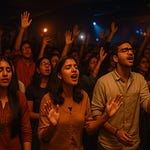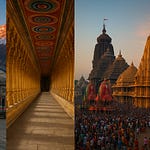A Temple of Divine Mystery and Power
Nestled in the rugged hills of Ramgarh district in Jharkhand, the Maa Chhinnamastika Temple at Rajrappa is one of India's most unique and spiritually charged Shaktipeeths. Dedicated to Maa Chhinnamastika, one of the ten Mahavidyas in the Tantric tradition, this temple is an embodiment of paradoxes—self-sacrifice and strength, violence and compassion, death and transcendence.
The temple is famous for its powerful spiritual vibrations, ancient rituals, and deep association with Tantric practices. Devotees from across India and beyond visit this sacred site to seek blessings, perform penance, and awaken inner energies.
🕉️ Who is Maa Chhinnamastika? – The Beheaded Goddess
Chhinnamastika (literally meaning "She who is beheaded") is a fierce form of the Mother Goddess, standing in a bold posture, holding her own severed head in one hand while blood streams gush from her neck to feed her two attendants, Dakini and Varnini.
🔱 Mythological Origin:
According to legend, once while roaming with her two attendants, they expressed hunger. To satisfy them, Maa Chhinnamasta beheaded herself, letting three blood streams emerge—two feeding her companions, and the third entering her own mouth. This represents self-sacrifice, liberation from ego, and the union of life and death.
📍 Location and Geographic Significance
Location: Rajrappa, Ramgarh District, Jharkhand, India
Confluence of Rivers: Situated at the mystical confluence of Bhairavi and Damodar rivers—considered highly sacred in Tantric texts
Coordinates: Approximately 80 km from Ranchi, 30 km from Ramgarh
Terrain: Surrounded by forested hills, waterfalls, and rocky terrain
This river confluence is believed to possess spiritual and purifying properties, and is often compared to Triveni Sangam in its sacredness.
🛕 History and Foundation of the Temple
The origins of the temple are lost in antiquity, but local legends and tantric traditions suggest that the site has been sacred for over 1,000 years. It is believed that the Matsya Purana and Tantric scriptures mention this spot as one of the ancient power centers where Shakti (Divine Feminine Energy) resides.
There is no firm archaeological date, but the architecture aligns with medieval Odisha-style temple construction, suggesting the temple was likely developed during 8th–11th centuries CE and continued evolving through regional patronage.
🏛️ Architecture and Design
Architectural Style: Resembles the Kalinga (Odisha) style of temple architecture
Material: Constructed with intricately carved sandstone blocks
Garbha Griha (Sanctum): Houses the headless statue of Maa Chhinnamastika in a standing pose on a copulating couple (symbolizing life force)
Other Shrines: Temples of Mahakali, Tara, Lord Shiva, Sun God, Hanuman, and Bhagwan Bhairav are also present within the complex
The blood symbolism, ritualistic carvings, and tantric motifs on walls are distinct and evoke awe, fear, and devotion simultaneously.
✨ Spiritual and Religious Significance
Maa Chhinnamastika Temple is considered a powerful Tantric Shaktipeeth. Unlike mainstream temples that represent nurturing forms of the Goddess, this temple is known for:
Symbolism of Self-Sacrifice & Detachment
Control over Desires and Ego
Awakening of Kundalini Energy
Balance between Creation and Destruction
Liberation (Moksha) through Inner Realization
The temple attracts both devotees seeking blessings and sadhakas pursuing Tantric enlightenment.
🔮 Mysteries and Tantric Practices
Beheading Imagery: Not symbolic, but literal—devotees believe this form embodies the highest form of spiritual renunciation.
Sacred Geometry: The temple site is said to lie on an energetic ley line, with intense Kundalini energy.
Tantric Rituals: Performed especially during Amavasya (new moon) and Navratri by advanced practitioners.
Bali Tradition: Animal sacrifices, especially of goats, are still offered by some devotees to fulfill vows (note: this is optional and regulated today).
Many visitors report experiencing divine visions, unusual calm, and even fear—indicating the powerful spiritual charge of the site.
🙏 Pujas, Rituals, and Worship
Daily Rituals:
Abhishek (sacred bath) with milk, water, honey
Offering of red flowers, sindoor, red cloth, and sweets
Chanting of mantras and tantric shlokas
Arti twice daily with conch, bells, and diya
Special Practices:
Manokamna Pooja (wish fulfillment)
Navratri Sadhanas (9-night worship)
Blood offerings (symbolic or real goat sacrifices)
🎉 Festivals Celebrated
Chaitra Navratri & Sharadiya Navratri – Grand processions, special sadhanas, and community feasts
Mahashivratri – Special significance due to the presence of Lord Shiva temples in the premises
Diwali & Kali Puja – Fierce energy worship with Tantric importance
Rajrappa Mela – A regional spiritual fair held annually
Amavasya & Purnima – Most powerful for Tantric rituals
During these times, lakhs of devotees and tantriks gather for blessings and energy work.
🕯️ Aarti & Temple Timings
Morning Aarti: 5:00 AM – 6:00 AM
Evening Aarti: 6:30 PM – 7:30 PM
Darshan Timings: 4:30 AM – 9:00 PM daily
Best Time to Visit: October to March (pleasant weather, major festivals)
The aarti is accompanied by chants, drums, and a trance-like rhythm that elevates the spiritual atmosphere.
🧭 How to Reach and What to Do
🚉 Nearest Railway Station:
Ramgarh (30 km)
Bokaro or Ranchi (connected by major trains)
✈️ Nearest Airport:
Birsa Munda Airport, Ranchi (about 80–90 km)
🚗 Road Connectivity:
Well-connected via NH23; buses, taxis, and autos easily available from Ranchi, Bokaro, Hazaribagh
✅ Things to Do:
Take a holy dip at the Bhairavi-Damodar Sangam
Perform puja or sankalp with a local priest
Visit nearby Rajrappa Waterfalls
Shop for religious artifacts and red saris in the temple market
Meditate near the riverfront or inside the mandap
Attend tantric discourses (occasionally held)
🧘🏻 For Spiritual Seekers and Tantrics
This temple is one of India’s rare non-mainstream shakti centers where Shakti worship meets Tantra in its raw form. It is especially significant for:
Kundalini Awakening
Shakti Sadhana
Control of Kama (desires)
Goddess Mahavidya Upasana
Many advanced Tantrikas, yogis, and seekers have visited this shrine for deeper mystical experiences.
Why Visit Rajrappa?
Maa Chhinnamastika Temple is more than a religious site—it's a spiritual phenomenon, a place where the boundary between fear and faith, death and liberation, illusion and truth blurs.
Whether you are a devotee seeking blessings, a seeker on a spiritual journey, or someone exploring India’s mystical sacred geography, this temple offers a powerful, unforgettable experience.










